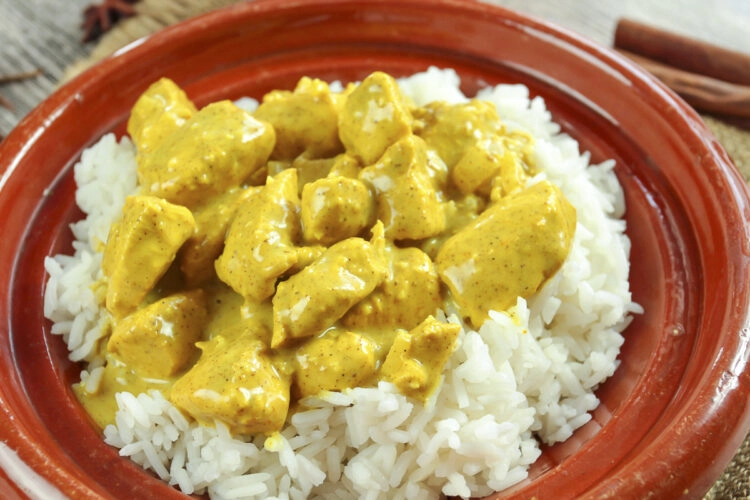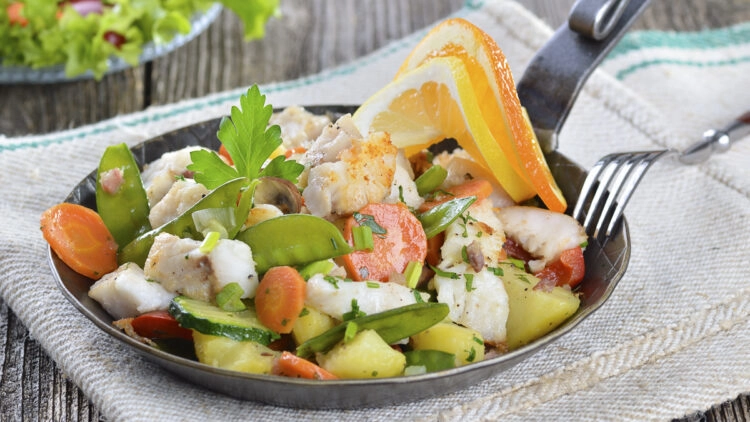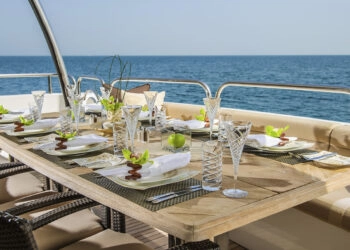The equipment of modern yachts is comparable to that of a luxurious vacation apartment. And the pantries look like well-thought-out fitted kitchens in which no corner is unused and which, with an L-shape opening onto the salon, invite guests to cook and sizzle together. Long gone are the days when provisioning was quickly completed with the stowage of many cans and ready-made meals. With a generous refrigerator, sometimes even a freezer, local delicacies stay fresh for a long time, and with a basic supply of provisions and spices, wonderful dishes can be conjured up on board.
Even the preparation is fun for everyone. Going to the local market gives you the best ideas for what to serve in the evening. And chopping and cooking vegetables together creates a real sense of community. But before you have to laboriously lug all the food on board during the individual tour destinations, it helps to make a few thoughts about the culinary offerings on board during the bulk purchase before setting sail at the base.
Everything that has a longer shelf life and does not need to be refrigerated can be purchased now. If there is already an approximate menu plan, special ingredients such as coconut milk, canned tuna or perfumed oils can be purchased right away. Also on the shopping list should be spices, because most pantries of the yachts are equipped for hygienic reasons very sparingly, often only pepper, salt and sugar are in the cupboard. Stock in cubes or grains is indispensable, as it gives many dishes the right zing. And pretty much every dish tastes better when made with onions or even garlic.
A different take on pasta
Sure, pasta with a classic sauce from a jar, which you only have to heat up, you can also do. If it has to go fast, no one from the crew really wants to let off steam creatively at the stove or the weather is so nasty that more than simple food heating is not to be thought.

Besides the classics Bolognese, Carbonara or even Aglio e Olio, the Smutje can also surprise the crew on a warm summer evening with Farfalle or Penne Rigate with a smart tomato-tuna sauce.
For the sauce (enough for about six servings) you need a liter of strained tomatoes (in a jar or tetra pack), three to four onions, two to three cloves of garlic, two cans of tuna natural, 100 grams of black pitted olives and a small jar of capers.
And here’s how it’s done: Sauté finely chopped onions and garlic in a saucepan, making sure they do not turn black. Then add the liquid strained tomatoes and bring everything to a boil, stirring gently (be careful not to splash!). Then stir in the tuna, cut into small pieces, and the olives and heat. Finally, season everything with salt and pepper. If you like, you can not add a jar of capers.
Refreshing gazpacho
This cold, Spanish vegetable soup is pleasantly light, tangy and perfect for mid-summer temperatures. What’s in the creamy soup? Lots of ripe tomatoes, cucumbers and peppers. To avoid having to painstakingly chop and puree everything on board, we recommend a ready-made soup from the tetrapack or even bottled as a base, which can be further pimped according to taste. The cold soup can be supplemented with anything that the market (or even the refrigerator) give, especially peppers, cucumber and zucchini refine the soup. If you have some stale bread or baguette that has become a little hard, you can add delicious croutons baked in olive oil to the soup. The soup becomes especially refined if you add a touch of cilantro.

Bread salad from the English celebrity chef
We’ll spare any clichéd remarks about English cuisine at this point and highly recommend the Tuscan bread salad with giant croutons created by Jamie Oliver, which we’re happy to add a crisp green salad alongside the vegetables used.
What goes in: Tomatoes in any shape and size (the small ones are the most aromatic), pickled grilled red peppers, garlic, parmesan. In addition, herbs, preferably rosemary, oregano and thyme. The dressing is made of olive oil, balsamic vinegar, sea salt, pepper and – if everyone from the crew agrees – anchovies. This rich salad, which makes a great accompaniment to grilled meats, is topped with ciabatta croutons, either pan-fried with plenty of olive oil or gently toasted in the oven.

Indian heat spiciness
Warm, well-seasoned food goes better with midsummer temperatures than you might think. Indian cuisine, with its many dishes that can be prepared in one pot, is therefore perfect for special taste experiences on board.
The chicken curry we recommend is the European answer to the nevertheless quite sharp, spicy taste of the popular dish of the Asian subcontinent.
This is what you need for about six servings: 800 grams of diced chicken breast fillets, about 20 grams of fresh ginger, curry powder, three red onions, garlic, a can of coconut milk, 250 grams of cream. Add pepper, salt, coriander and a cube of chicken broth.

How to make: Put ginger, garlic and onions in a saucepan and sauté until translucent, then add the diced chicken breast pieces and sauté. Then add cream, coconut milk, two teaspoons of curry powder and chicken broth, bring everything to a boil together and then simmer on low heat for about 15 minutes. Just before serving, season with cilantro or garnish if there were fresh herbs. Any form of rice goes well with this, it doesn’t have to be basmati.
Catch of the day
For amateur chefs on a cruise, there are few things better than buying a freshly caught fish from the fishermen on the pier in the morning. But for a large crew and with the limited space available on board, preparing several complete fish is costly, complicated, and it’s unlikely to succeed in getting food on the table for everyone at the same time. That doesn’t mean you have to miss out on fresh fish!

Buy several different fillets and use them to create a fish skillet with fresh vegetables. When choosing vegetables, you can easily vary and go with what is freshly available. Tomatoes, peppers, zucchini and sugar snap peas are particularly well suited to complement the different types of fish.
How it’s done: Actually as always, first onions and garlic are gently sautéed, then the chopped vegetables are added. Only at the very end, the pieces of fish are carefully added – attention, turn gently so that they do not disintegrate. Before serving, season with salt and pepper and bring to the table with a piece of lemon. Rice is a suitable side dish for this.
Use leftovers
Nothing is more annoying than having way too much food left over at the end of the cruise. Hardly anyone takes packets of pasta and kitchen herbs on the journey home. Even if the marina staff is sometimes happy to take over unopened food, very few people need as much pasta and rice as some charter crews have left over at the end of the trip. So it is better to check critically on board two days before the end of the tour what is still there, before buying fresh again. On the last evening, however, the kitchen should remain cold – at the latest then it goes into a local restaurant and all let themselves taste the regional specialties.












